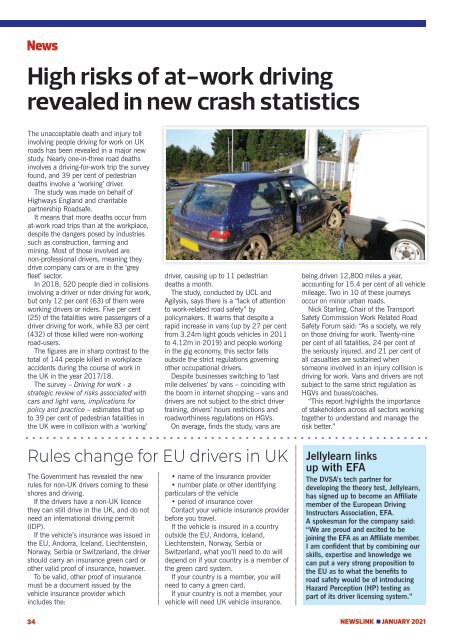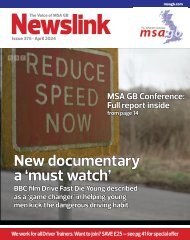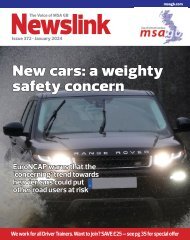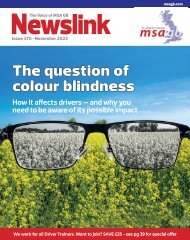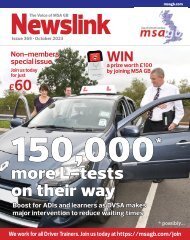Newslink
Motor Schools Association membership magazine, driver training and testing, ADIs, road safety
Motor Schools Association membership magazine, driver training and testing, ADIs, road safety
You also want an ePaper? Increase the reach of your titles
YUMPU automatically turns print PDFs into web optimized ePapers that Google loves.
News<br />
High risks of at-work driving<br />
revealed in new crash statistics<br />
The unacceptable death and injury toll<br />
involving people driving for work on UK<br />
roads has been revealed in a major new<br />
study. Nearly one-in-three road deaths<br />
involves a driving-for-work trip the survey<br />
found, and 39 per cent of pedestrian<br />
deaths involve a ‘working’ driver.<br />
The study was made on behalf of<br />
Highways England and charitable<br />
partnership Roadsafe.<br />
It means that more deaths occur from<br />
at-work road trips than at the workplace,<br />
despite the dangers posed by industries<br />
such as construction, farming and<br />
mining. Most of those involved are<br />
non-professional drivers, meaning they<br />
drive company cars or are in the ‘grey<br />
fleet’ sector.<br />
In 2018, 520 people died in collisions<br />
involving a driver or rider driving for work,<br />
but only 12 per cent (63) of them were<br />
working drivers or riders. Five per cent<br />
(25) of the fatalities were passengers of a<br />
driver driving for work, while 83 per cent<br />
(432) of those killed were non-working<br />
road-users.<br />
The figures are in sharp contrast to the<br />
total of 144 people killed in workplace<br />
accidents during the course of work in<br />
the UK in the year 2017/18.<br />
The survey – Driving for work - a<br />
strategic review of risks associated with<br />
cars and light vans, implications for<br />
policy and practice – estimates that up<br />
to 39 per cent of pedestrian fatalities in<br />
the UK were in collision with a ‘working’<br />
driver, causing up to 11 pedestrian<br />
deaths a month.<br />
The study, conducted by UCL and<br />
Agilysis, says there is a “lack of attention<br />
to work-related road safety” by<br />
policymakers. It warns that despite a<br />
rapid increase in vans (up by 27 per cent<br />
from 3.24m light goods vehicles in 2011<br />
to 4.12m in 2019) and people working<br />
in the gig economy, this sector falls<br />
outside the strict regulations governing<br />
other occupational drivers.<br />
Despite businesses switching to ‘last<br />
mile deliveries’ by vans – coinciding with<br />
the boom in internet shopping – vans and<br />
drivers are not subject to the strict driver<br />
training, drivers’ hours restrictions and<br />
roadworthiness regulations on HGVs.<br />
On average, finds the study, vans are<br />
being driven 12,800 miles a year,<br />
accounting for 15.4 per cent of all vehicle<br />
mileage. Two in 10 of these journeys<br />
occur on minor urban roads.<br />
Nick Starling, Chair of the Transport<br />
Safety Commission Work Related Road<br />
Safety Forum said: “As a society, we rely<br />
on those driving for work. Twenty-nine<br />
per cent of all fatalities, 24 per cent of<br />
the seriously injured, and 21 per cent of<br />
all casualties are sustained when<br />
someone involved in an injury collision is<br />
driving for work. Vans and drivers are not<br />
subject to the same strict regulation as<br />
HGVs and buses/coaches.<br />
“This report highlights the importance<br />
of stakeholders across all sectors working<br />
together to understand and manage the<br />
risk better.”<br />
Rules change for EU drivers in UK<br />
The Government has revealed the new<br />
rules for non-UK drivers coming to these<br />
shores and driving.<br />
If the drivers have a non-UK licence<br />
they can still drive in the UK, and do not<br />
need an international driving permit<br />
(IDP).<br />
If the vehicle’s insurance was issued in<br />
the EU, Andorra, Iceland, Liechtenstein,<br />
Norway, Serbia or Switzerland, the driver<br />
should carry an insurance green card or<br />
other valid proof of insurance, however.<br />
To be valid, other proof of insurance<br />
must be a document issued by the<br />
vehicle insurance provider which<br />
includes the:<br />
34<br />
• name of the insurance provider<br />
• number plate or other identifying<br />
particulars of the vehicle<br />
• period of insurance cover<br />
Contact your vehicle insurance provider<br />
before you travel.<br />
If the vehicle is insured in a country<br />
outside the EU, Andorra, Iceland,<br />
Liechtenstein, Norway, Serbia or<br />
Switzerland, what you’ll need to do will<br />
depend on if your country is a member of<br />
the green card system.<br />
If your country is a member, you will<br />
need to carry a green card.<br />
If your country is not a member, your<br />
vehicle will need UK vehicle insurance.<br />
Jellylearn links<br />
up with EFA<br />
The DVSA’s tech partner for<br />
developing the theory test, Jellylearn,<br />
has signed up to become an Affiliate<br />
member of the European Driving<br />
Instructors Association, EFA.<br />
A spokesman for the company said:<br />
“We are proud and excited to be<br />
joining the EFA as an Affiliate member.<br />
I am confident that by combining our<br />
skills, expertise and knowledge we<br />
can put a very strong proposition to<br />
the EU as to what the benefits to<br />
road safety would be of introducing<br />
Hazard Perception (HP) testing as<br />
part of its driver licensing system.”<br />
NEWSLINK n JANUARY 2021


